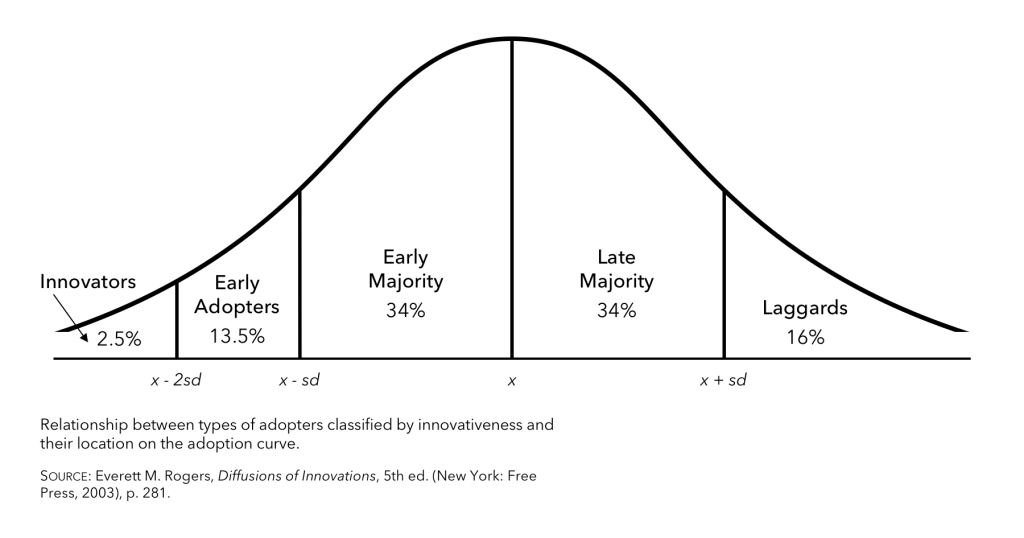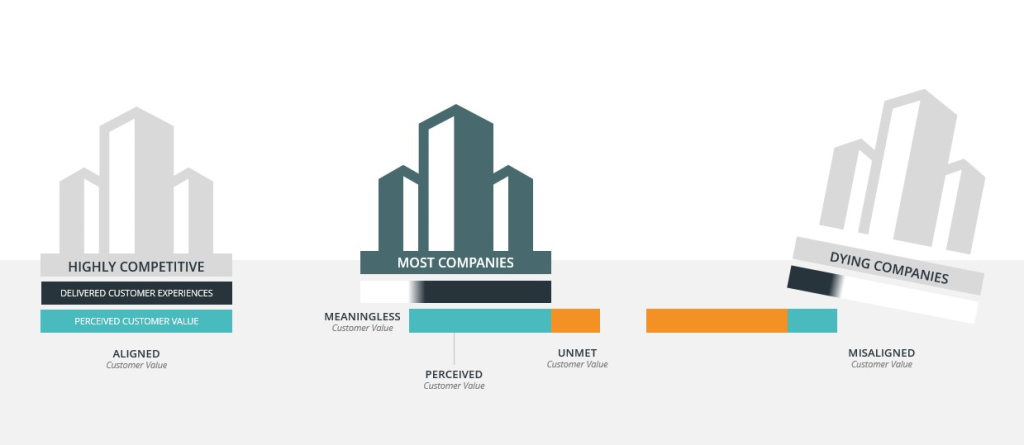Is it possible to disruption-proof your business? Judging by number of household brand names that we’ve seen come and go at the hands of disruptive innovation, it may not seem like it.
But there is also the common misconception that agile startups are the only companies capable of disruption, and that well-established, enterprise players are almost always disrupted.
We’re here to tell you that this is not necessarily the case.
- Customers disrupt markets, not companies. Adoption of new technology relies on customers’ decisions and how well their pains and needs are being addressed by current players.
- Disruptive Innovation can and has been curbed through incremental innovation.
- Companies that stay aligned with Customer Value can disruption-proof themselves by continuously tracking how disruption is reshaping the competitive landscape.
Customers Disrupt Markets, Not Companies

E.M. Rogers’ “Adoption Curve” is an important consideration when analyzing the full potential of innovation. The product adoption curve is broken down into five stages: innovators, early adopters, early majority, late majority, and laggards.
Each stage has a set of advantages and challenges that can help or hinder customer adoption.
But in fact, most innovation never gets past the early adopter stage.
This is because, while the early majority offers the largest market size and growth potential, there is a chasm between early adopters and early majority.
Unlike innovators and early adopters, customers in the early majority need an element of social proof before venturing into the unknown. In other words,
“I’ll wait for someone else (early adopter) with influence to try this first and tell me whether it’s worth it or not”.
This means that, crossing the chasm depends on a products’ success in being adopted and championed by early adopters.
So, understanding how and why a product was a fit to that early consumer market is essential to sustain growth and adoption of disruptive innovation.
But a word to the wise: it’s usually a mistake to assume that because you have successfully disrupted an industry before, you can do it again.
The fact is, no amount of technical expertise or inventiveness guarantees that customers will find value in the product. They make the decision to buy, and by extension, they decide what you can sell.
The best you can do is track customers’ decisions, work hard to understand what is driving those decisions, and act on that knowledge.
Disruptive Innovation Can be Curbed Through Incremental Innovation
As mentioned above, most innovation never gets past the early adopter stage. Take Google, for example. The tech giant has 271 active products. Of those, only 7 have wide-spread, global adoption.
It is estimated that Google has killed over 280 products, and will continue to do so mercilessly once and if that product fails to cross the chasm.
So, how does Google consistently maintain its innovator status despite infrequent disruptive innovation? Through the incremental innovation of its most successful products.
Apple too has become the most valuable company on the planet through very little disruptive innovation and a whole lot of consistently customer-focused incremental innovation.
In fact, Apple has invented very few of its celebrated best-sellers. They did not invent the PC, the mp3 player, the smart phone, or the wireless earphones.
They did, however, perfect, redesign, and market these products into iconic status symbols which they continuously build upon year over year through incremental innovation.
And despite constant criticism from tech pundits claiming Apple innovates too little, customers seem to disagree, and so does the stock market.
So, what is the correct strategy? I would argue both. There is no clear-cut rule on how or when to innovate because the decision truly lies with the customer, and whether they continue to perceive value in your product or not.
Know when customers are ready for disruption
The ideal moment for disruptive innovation is when customers begin to perceive more value in market alternatives with innovative solutions.
The problem is, if companies aren’t keeping close tabs on the state of their market, customers can become ripe for disruptive change before the company realizes it, and that’s when they run the risk of a more strategic company beating them to the punch.
We are experiencing a perfect example of this now. ChatGPT is, in Google’s own words, the biggest threat to search engines ever, and it’s still in beta.
It grew to 5 million users in a matter of days and continues to rocket upwards, making it the fastest adoption of any consumer app on record. The problem is that Google saw this threat coming and took too long to act on it.
And while ultimately, they plan to launch a rival platform, Bard, instead of being the first mover, they are now at a disadvantage, trailing behind the success of their disruptor.
How can companies become disruption-proof using Customer Value Alignment?
Knowing when disruption is imminent is the most important part of avoiding it. To be as disruption-proof as possible, companies must continuously track where customers find value and what can be changed to maximize that value, and it needs to be done fast.
This gets more challenging the larger a company gets, as it acquires more customers and grows its product and service portfolio. The motto of unicorns everywhere seems to be “move fast and break things”.
Wouldn’t it be better if they could move fast and fix things instead? That’s what Customer Value Alignment is all about.
In healthy companies, a significant portion of what they deliver aligns with Perceived Customer Value.
The ideal (read: unattainable) company is in 100% alignment with its customers.
Most companies have a large degree of alignment with Perceived Customer Value, as well as some areas of misalignment.
Meaningless Value is something unperceived by customers, and Unmet Value is perceived by customers as an opportunity to add further value.
These are both areas the company can affect to increase Perceived Customer Value. Companies with too much Unmet or Unperceived value are misaligned and at the most risk of dying out.

Opportunities for innovation can usually be found in the Unmet portion. To understand whether to make incremental or disruptive innovations, you have to go deeper and analyze customers’ own words.
What specific parts of their journey with you aren’t up to their expectations? What creates customer value, and what destroys it? Who is the biggest competitor in your space?
These are all questions you have to answer to make the best strategic judgments.
A great example of using the appropriate response to combat disruption is the Insurance space that was just recently under the threat of disruption from InsurTech.
The curious part of this story is that traditional Insurance was never disrupted. Why you ask? Because the industry was able to recognize the gap between what they delivered and what customers needed which had left room for disruption in the first place.
And then, they put in the work and closed that gap through incremental innovation, coming up to speed with their challengers from a technology perspective whilst maintaining an upper hand on market trust and wide-spread adoption.
The so-called Retail Apocalypse which would be brought on by e-commerce also never came to fruition. Did many shoppers move online?
Yes. Did brick-and-mortar come to an end? Absolutely not. In fact, it has grown! Retail leaders simply adapted to fit customers’ new values.
The layout and size of stores changed, and became more experiential, with online stores working alongside physical locations as a complementary channel of revenue.
The goal of any company is to be aligned with that customer value, and to do so without gambling on big, costly innovations.
The challenge is knowing when and how to make innovations in a way that’s fast, reliable, and cost-efficient. That’s practically a superpower in today’s rapid and volatile business world, but that ability is closer than you think.





